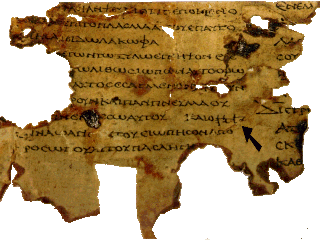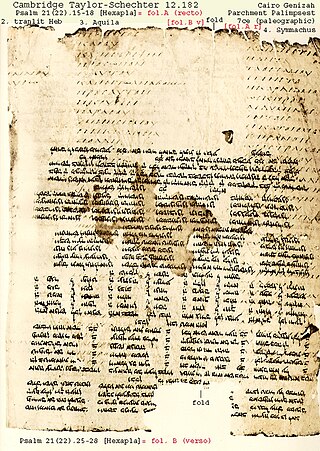
The Septuagint, sometimes referred to as the Greek Old Testament or The Translation of the Seventy, and often abbreviated as LXX, is the earliest extant Greek translation of the Hebrew Bible from the original Hebrew. The full Greek title derives from the story recorded in the Letter of Aristeas to Philocrates that "the laws of the Jews" were translated into the Greek language at the request of Ptolemy II Philadelphus by seventy-two Hebrew translators—six from each of the Twelve Tribes of Israel.
In contrast to the variety of absolute or personal names of God in the Old Testament, the New Testament uses only two, according to the International Standard Bible Encyclopaedia. From the 20th century onwards, "a number of scholars find various evidence for the name [YHWH or related form] in the New Testament.

The Tetragrammaton, or the Tetragram, is the four-letter Hebrew theonym יהוה, the name of God in the Hebrew Bible. The four letters, written and read from right to left, are yodh, he, waw, and he. The name may be derived from a verb that means "to be", "to exist", "to cause to become", or "to come to pass", While there is no consensus about the structure and etymology of the name, the form Yahweh is now accepted almost universally, though the vocalization Jehovah continues to have wide usage.

Codex Marchalianus designated by siglum Q is a 6th-century Greek manuscript copy of the Greek version of the Hebrew Bible known as the Septuagint. The text was written on vellum in uncial letters. Palaeographically it has been assigned to the 6th century. Marginal annotations were later added to the copy of the Scripture text, the early ones being of importance for a study of the history of the Septuagint.

Papyrus Rylands 458 is a manuscript of the Pentateuch in the Greek Septuagint version of the Hebrew Bible. It is a roll made from papyrus, which has survived in a very fragmentary condition. It is designated by the number 957 on the list of Septuagint manuscripts according to the numbering system devised by biblical scholar Alfred Rahlfs. Using the study of comparative writing styles (palaeography), the manuscript has been dated to the middle of the 2nd century BCE.

The Papyrus Fouad 266 are fragments, part of a papyrus manuscript in scroll form containing the Greek translation, known as the Septuagint, of the Pentateuch. They have been assigned palaeographically to the 1st century BCE. There is discussion about whether the text is original or a later recension of the Septuagint.

The Greek Minor Prophets Scroll from Nahal Hever is a Greek manuscript of a revision of the Septuagint dated to the 1st century BC and the 1st century CE. The manuscript is kept in the Rockefeller Museum in Jerusalem. It was first published by Dominique Barthélemy in 1963. The Rahlfs-Siglum is 943.

The Papyrus LXX Oxyrhynchus 3522, – is a small fragment of the Greek Septuagint (LXX) written in papyrus, in scroll form. As one of the manuscripts discovered at Oxyrhynchus it has been catalogued with the number 3522. Palaeographically it has been dated to the 1st century CE. The text agrees with the LXX.

Papyrus Oxyrhynchus 5101, designated by 2227, or P.Oxy.77 (LXXVII) 5101, is a manuscript of the Greek Septuagint Psalms, written on papyrus in roll form. It has survived in a very fragmentary condition. Using the study of comparative writings styles (palaeography), it has been dated to the middle of the first - middle of the second century CE.

Papyrus Oxyrhynchus 656 – is a Greek fragment of a Septuagint manuscript written on papyrus in codex form. This is a manuscript discovered at Oxyrhynchus, and it has been catalogued with number 656. Palaeographycally it is dated to late second century or early third century.

The kaige revision, or simply kaige, is the group of revisions to the Septuagint made in order to more closely align its translation with the proto-Masoretic Hebrew. The name kaige derives from the revision's pervasive use of Koinē Greek: και γε to translate the Hebrew: וְגַם. The importance of this revision lies in its status as a precursor to later revisions by 'the Three' as well as the light it sheds on the origins of the Septuagint.

4Q122 – is a septuagint manuscript written on parchment, dated from second century B.C.E.. The scroll contains a fragment of the biblical Book of Deuteronomy 11:4. It was found in a cave at Qumran in Cave 4. This fragment is also referred to as number 819 on the list of the Septuagint manuscripts according classification system by Alfred Rahlfs.

The siglum Taylor-Schechter 12.182 designates a manuscript written on parchment in codex form. This is a palimpsest of a copy of Origen's work called the Hexapla. The manuscript is dated to 7th-century AD, and is the oldest of the hexapla manuscripts. The hexapla was completed before 240 CE.
4Q121 is a Septuagint manuscript written on parchment, dated to the 1st century BCE or CE. The scroll contains fragments of the biblical Book of Numbers 3:40-43; 4:5-16. It was found in Qumran in Cave 4. This fragment is also numbered 803 in the list of manuscripts of the Septuagint by Alfred Rahlfs. The manuscript has been assigned palaeographically between 30 BCE and 68 CE.
Papyrus Oxyrhynchus 4443 is a fragment of a Septuagint manuscript (LXX) written on papyrus in scroll form. It is the oldest extant manuscript that contains Esther 8:16–9:3 of the Septuagint text and verse numbering, according to the text of LXX. The manuscript has been assigned palaeographically to 50–150 CE.

The manuscript 4Q127 is one of the Dead Sea Scrolls. It is probably a paraphrase of Exodus according to the Septuagint (LXX) of the biblical Book of Leviticus, found at Qumran. The Rahlfs-No. is 802. Palaeographically it dates from the first century BC. Currently the manuscript is housed in the Rockefeller Museum in Jerusalem.

The 4Q126 is an ancient Greek fragment and one of the Dead Sea Scrolls. The text of this manuscript is unknown and it has not been possible to identify it with any known LXX passage, a biblical verse or from some other literary work. Palaeographically it dates from the first century BCE or early first century CE.
Pavlos D. Vasileiadis is a Greek biblical scholar. His research is focused on biblical theology and biblical translation, with emphasis on the textual criticism of the New Testament and the research of the diachronic reception of the Tetragrammaton in Greek literature. He has been an author of the Μεγάλη Ορθόδοξη Χριστιανική Εγκυκλοπαίδεια (MOXE) [Great Orthodox Christian Encyclopedia]. For over two decades he has been an educational professional in the field of information technology.
Frank Edward Shaw is a retired professor and the originator of the theory that there was no single original form of writing of the name of God in the Greek Bible, instead of Ιαω, transliterations in square Hebrew characters, in paleo-Hebrew characters, Greek characteres ΠΙΠΙ, Θεὀς or, contrary to the more common opinion, of an original κύριος.
Dead Sea Scrolls manuscript 7Q1 is an early fragmentary manuscript of the Greek Bible containing verses from the Book of Exodus 28:4–7, written on papyrus. Using the study of comparative writing styles (palaeography), it has been dated to the hasmonean period, about late 2nd-early 1st century BCE.














